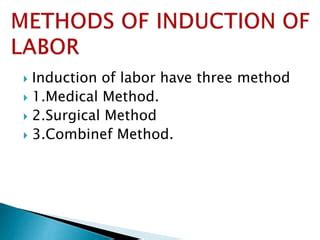Intro
Learn 5 natural ways to induce labor, including exercise, acupressure, and nutrition, to help stimulate childbirth and reduce pregnancy duration with safe and effective methods.
The anticipation of meeting your new baby can be overwhelming, and for some mothers, the wait can feel like an eternity. While it's essential to allow your baby to develop fully, there are situations where inducing labor might be necessary or desirable. Whether you're past your due date or have medical concerns, understanding the various methods to induce labor can help you make informed decisions about your pregnancy. In this article, we'll delve into the world of labor induction, exploring the benefits, risks, and techniques involved.
As you approach your due date, it's natural to wonder about the process of labor and how it can be initiated. Labor induction is a medical procedure that stimulates uterine contractions to help your body prepare for childbirth. This can be done for various reasons, including post-date pregnancies, gestational diabetes, or concerns about the baby's health. While some women may prefer to wait for labor to start naturally, others may opt for induction to avoid potential complications or to have more control over the birthing process.
The decision to induce labor should be made in consultation with your healthcare provider, as they will assess your individual situation and recommend the best course of action. Your provider will consider factors such as your overall health, the baby's well-being, and the likelihood of a successful induction. It's crucial to discuss your options and any concerns you may have, ensuring that you're well-informed and comfortable with the decision. With the right guidance and support, you can navigate the process of labor induction and welcome your new baby into the world.
Understanding Labor Induction

Benefits of Labor Induction
The benefits of labor induction are numerous, and they can be particularly significant for women with high-risk pregnancies. Some of the advantages of inducing labor include: * Reduced risk of stillbirth: Inducing labor can help reduce the risk of stillbirth, especially in women who are past their due date. * Lower risk of complications: Labor induction can help prevent complications such as gestational diabetes, high blood pressure, and placental abruption. * Increased control: Inducing labor can give women more control over the birthing process, allowing them to plan and prepare for the arrival of their baby. * Reduced anxiety: Knowing when labor will start can help reduce anxiety and make the birthing process less stressful.Methods of Labor Induction

Risks and Complications
While labor induction can be a safe and effective way to bring on labor, there are potential risks and complications to be aware of. Some of the possible risks include: * Uterine hyperstimulation: This is a condition where the uterus contracts too frequently, which can cause fetal distress. * Fetal distress: This is a condition where the baby becomes stressed due to lack of oxygen or other complications. * Infection: There is a risk of infection with any medical procedure, including labor induction. * Prolonged labor: Labor induction can sometimes lead to prolonged labor, which can increase the risk of complications.5 Ways to Induce Labor

Preparing for Labor Induction
If you're considering inducing labor, it's essential to prepare yourself physically and emotionally. Here are some tips to help you prepare: * Stay hydrated: Drinking plenty of water can help your body prepare for labor and reduce the risk of complications. * Eat a healthy diet: Eating a balanced diet rich in nutrients can help your body prepare for labor and support your overall health. * Get plenty of rest: Resting and conserving your energy can help you prepare for the physical demands of labor. * Practice relaxation techniques: Practicing relaxation techniques such as deep breathing, meditation, or yoga can help reduce stress and anxiety.Conclusion and Next Steps

Final Thoughts
As you prepare for the arrival of your new baby, remember that every pregnancy is unique, and what works for one woman may not work for another. Stay informed, stay flexible, and trust your healthcare provider to guide you through the process. With patience, support, and the right mindset, you can navigate the journey of labor induction and start your new life as a mother.What are the benefits of labor induction?
+Labor induction can help reduce the risk of stillbirth, lower the risk of complications, and give women more control over the birthing process.
What are the risks of labor induction?
+The risks of labor induction include uterine hyperstimulation, fetal distress, infection, and prolonged labor.
How can I prepare for labor induction?
+To prepare for labor induction, stay hydrated, eat a healthy diet, get plenty of rest, and practice relaxation techniques such as deep breathing, meditation, or yoga.
What are some natural methods of labor induction?
+Natural methods of labor induction include nipple stimulation, castor oil, acupuncture, red raspberry leaf tea, and sex.
How can I reduce the risk of complications during labor induction?
+To reduce the risk of complications during labor induction, stay hydrated, eat a healthy diet, get plenty of rest, and follow your healthcare provider's instructions.
